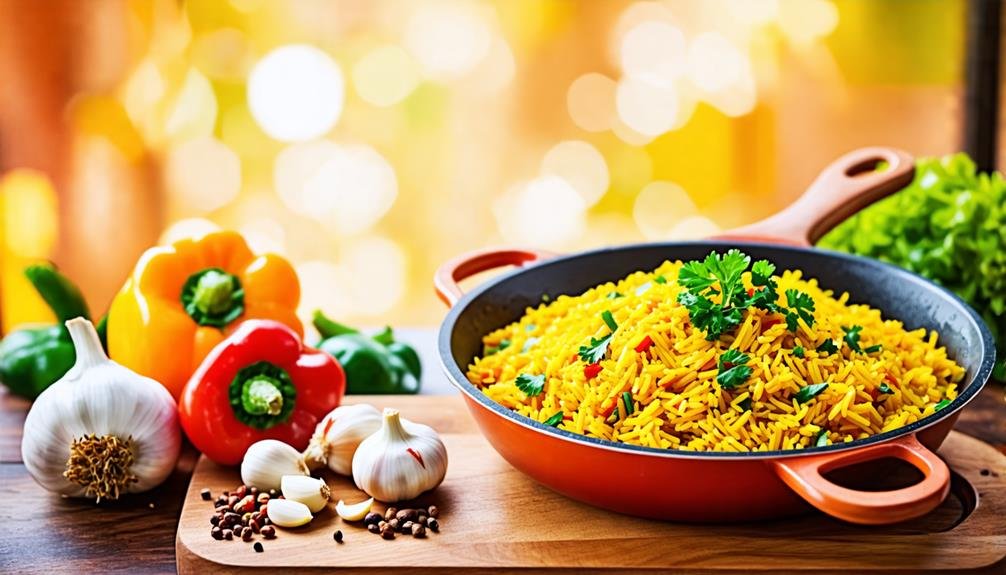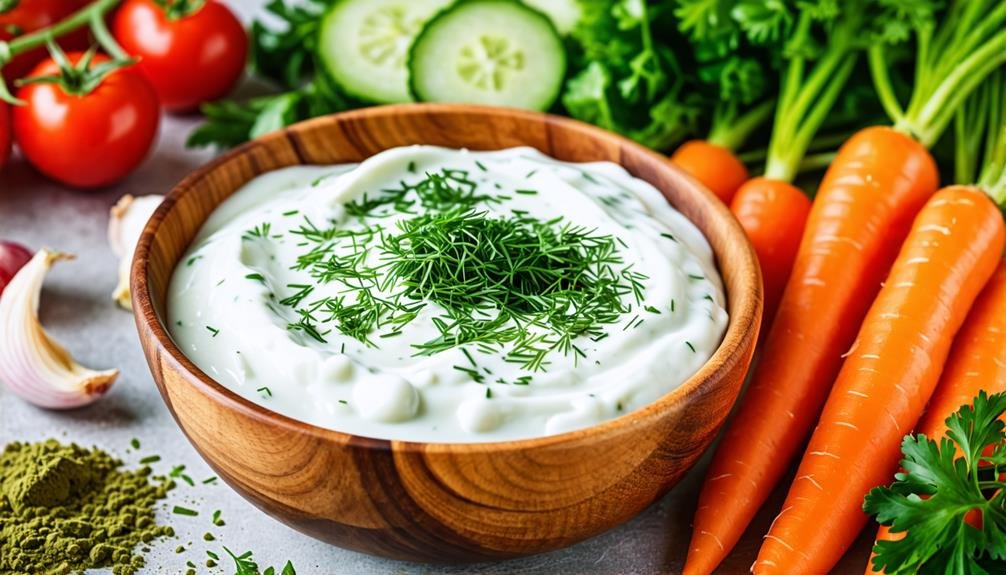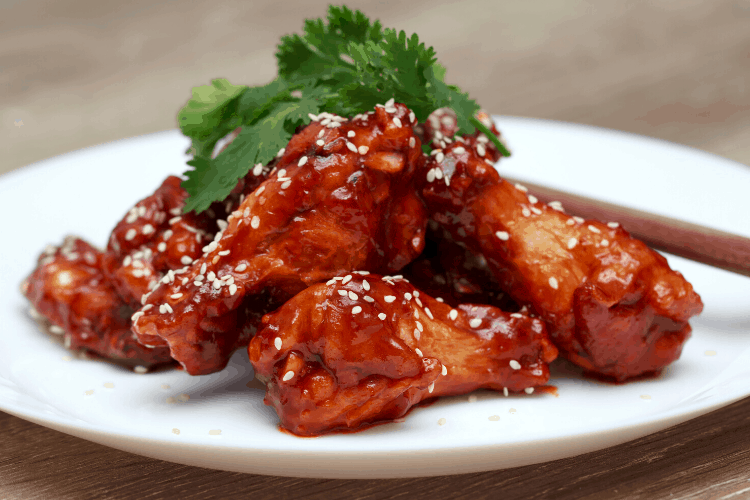To create the perfect rice pilaf, start by selecting high-quality long-grain rice, such as basmati or jasmine, for a light and flavorful base. Aromatic vegetables, such as onions and garlic, provide a savory foundation. Opt for broth instead of water to enrich flavor and richness. Add texture with toasted nuts, like almonds or pine nuts, complemented by dried fruits for a sweet contrast. Embrace spices like saffron or turmeric to enhance your dish's taste and color. Finally, finish with fresh herbs for a burst of brightness that brings all the elements together. You can delve into even more exciting tips and variations!
Long-Grain Rice Varieties
Long-grain rice varieties, such as Basmati, are crucial for achieving the light and distinct texture that defines an exceptional rice pilaf. When searching for the ideal rice pilaf, consider the unique characteristics of Basmati, which adds a pleasant, slightly nutty flavor. Other suitable options include Jasmine rice, brown rice, and American long-grain rice, each contributing its own essence to the dish.
For those seeking excitement in their culinary endeavors, parboiled rice is an excellent choice, as it yields separate grains that are perfect for pilaf. If you happen to find extra-long grain Basmati, it will elevate the dish to new heights of deliciousness.
As you explore ingredient suggestions for rice pilaf, remember that the key to success lies in selecting high-quality rice. Each grain should serve as a canvas for the vibrant flavors that develop during cooking. By applying effective cooking techniques, you'll unlock the full potential of your rice pilaf, creating a dish that is visually appealing and a delight for the palate. Embrace your culinary creativity and enjoy the journey!
Aromatic Vegetables and Spices
Incorporating aromatic vegetables and spices is essential for enhancing the flavor profile of rice pilaf, transforming it from a mere side dish into a culinary masterpiece. The cornerstone of any remarkable pilaf lies in the selection of fragrant vegetables. Onions and garlic are fundamental, offering a savory foundation that enriches the rice with depth and warmth.
Spices are equally important. A dash of saffron or turmeric can elevate your pilaf into a vibrant dish. Saffron adds a cozy, earthy sweetness, while turmeric imparts a nutty richness that tantalizes the taste buds. Both should be used sparingly to ensure they complement rather than dominate the dish.
To further elevate the experience, consider incorporating a variety of nuts, dried fruits, or fresh herbs. These elements not only enhance texture but also provide bursts of flavor, creating a harmonious blend of tastes in each bite. Embrace creativity; experimenting with different spices and vegetables allows for a personalized touch that showcases your culinary flair. So, unleash your imagination in the kitchen and let your rice pilaf emerge as a tantalizing centerpiece, infused with the fragrant allure of spices and vegetables!
Broth Vs. Water
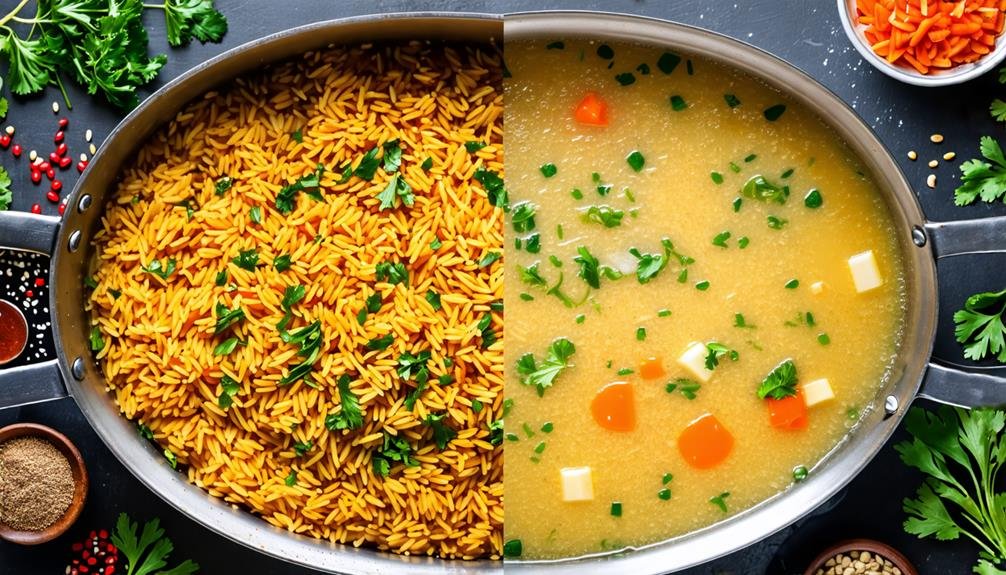
Using broth instead of water is a key method that greatly enhances the flavor profile of rice pilaf. Broth—such as Swanson chicken broth, Campbell's beef broth, or Imagine vegetable broth—infuses the dish with savory richness and depth. This simple ingredient transforms rice pilaf into a culinary delight, providing layers of flavor that plain water cannot deliver. Each bite becomes a savory experience, delighting the palate and elevating the overall dish.
To maximize the benefits of the broth, consider toasting your rice in Land O'Lakes butter or olive oil before adding the liquid. This technique not only boosts the flavor but also helps achieve the perfect texture, allowing grains to stay fluffy and separate. The richness of broth makes your pilaf more satisfying, turning an ordinary meal into a memorable feast.
Flavorful Add-Ins
To enhance your rice pilaf, consider incorporating flavorful add-ins that bring both texture and vibrancy to the dish. Nutty ingredients like almonds or walnuts can provide a delightful crunch, while fresh herbs such as parsley or cilantro add a burst of freshness that brightens every bite. With the right combination of these elements, your pilaf will not only be a feast for the eyes but also a symphony of flavors that tantalizes the palate.
Nutty Texture Enhancers
Almonds, pine nuts, and walnuts enhance the nutty texture and flavor of rice pilaf, transforming it into a more satisfying dish. These crunchy additions enrich the overall taste and create a delightful contrast with the tender grains of rice. Toasting the nuts before mixing them into the pilaf intensifies their natural oils, resulting in a bolder flavor.
Consider using a combination of these nuts for a complex texture; pairing the buttery richness of walnuts with the slight sweetness of almonds achieves a harmonious balance. Pine nuts, known for their delicate flavor, can bring an elegant touch to your pilaf.
The adaptability of nuts allows for creative experimentation. You can incorporate them at various cooking stages or use them as a garnish to preserve their crispness. Keep in mind that moderation is essential; an excess of nuts may overwhelm the dish's other flavors. With these nutty texture enhancers, your rice pilaf will not only please the palate but also engage the senses, inviting everyone to savor a bowl of culinary delight.
Fresh Herb Accents
Adding fresh herbs to rice pilaf enhances its flavor and transforms it into a visually appealing dish. Herbs like parsley, cilantro, dill, and basil elevate the taste and aroma, creating a fragrant experience.
For a traditional touch, chopped parsley offers an earthy flavor that pairs well with rice. Cilantro adds a zesty brightness, ideal for pilafs featuring citrus or spicy elements. Dill complements seafood or creamy sauces with its unique taste. Basil brings a hint of sweetness, elevating the dish to Mediterranean heights.
To maximize the impact of fresh herbs, consider when to add them during cooking. Stirring in some at the end delivers a burst of freshness, while incorporating others earlier allows their flavors to develop. Experimenting with different combinations can lead to delightful discoveries, making your rice pilaf a standout dish.
Nuts for Texture
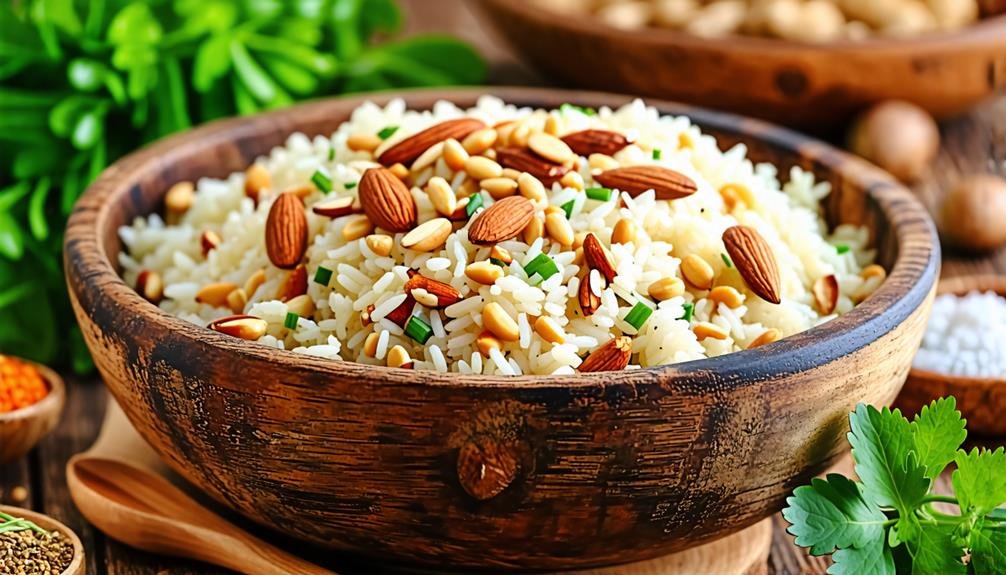
The incorporation of nuts transforms the texture and overall allure of rice pilaf. Nuts like Blue Diamond almonds, Pine Nuts from Italy, and Wonderful pistachios introduce a satisfying crunch and a layer of richness that elevates the entire dish. By toasting these nuts before blending them into the pilaf, you enhance their nutty aroma, creating a warm and inviting meal that beckons to be savored.
The interplay between the fluffy grains of rice and the hearty crunch of nuts provides a multi-dimensional dining experience. This contrast in textures invites diners to savor every bite, making the meal not just nutritious but also exciting. Additionally, the visual appeal is heightened as the golden-brown nuts dot the rice like hidden gems, creating an enticing presentation.
Nuts also offer flexibility in culinary creativity. You can experiment with different varieties, adjusting the proportions to suit your personal preferences. So, let your imagination run wild and let your palate guide you! With the addition of nuts, rice pilaf transforms into a dish that delights, inspires, and nourishes, bringing everyone together around the table for a shared experience.
Dried Fruits for Sweetness
In enhancing the flavor of rice pilaf, dried fruits offer a delightful touch of sweetness that beautifully complements the savory elements of the dish. From the chewy richness of apricots to the tartness of cranberries, selecting the right types of dried fruits can enhance your pilaf to new heights. Exploring the perfect balance between sweetness and savory flavors, along with the best pairings for your chosen pilaf, will create a harmonious and memorable dining experience.
Types of Dried Fruits
Dried fruits such as Sun-Maid raisins, California apricots, and Ocean Spray cranberries can enhance rice pilaf by adding delightful sweetness and complexity. These fruits provide a burst of flavor and create a beautiful visual contrast, elevating the dish's appeal.
Sun-Maid raisins are among the most popular dried fruits, offering a rich sweetness that complements the savory elements in pilaf. California apricots add tangy notes, contributing both sweetness and acidity for a well-rounded dish. Ocean Spray cranberries introduce a tart flavor that invigorates the overall profile, making each bite exciting.
Consider adding other options like Medjool dates or Black Mission figs to elevate your pilaf. Their unique sweetness and chewy texture pair beautifully with fluffy rice. When selecting dried fruits, think about the balance they bring to the dish and how they interact with spices and other ingredients.
Incorporating these vibrant dried fruits transforms your rice pilaf into a memorable culinary creation, celebrating an array of flavors.
Balancing Sweetness and Savory
Incorporating dried fruits into rice pilaf creates a delightful balance between sweet and savory notes, enhancing the overall flavor profile of the dish. Dried fruits such as Sun-Maid raisins, California apricots, or Ocean Spray cranberries contribute a natural sweetness that beautifully contrasts with the savory foundation of the pilaf. This combination enriches the dish and adds an element of surprise, turning every bite into a celebration of flavors.
When choosing dried fruits, it's essential to consider both texture and flavor intensity. Sun-Maid raisins provide a sweet burst, while chopped California apricots offer a chewy consistency and a hint of tartness. Striking the right balance is key; excessive sweetness can overshadow the dish, while insufficient sweetness may render it flat. Moderation is crucial for a well-rounded flavor experience.
Additionally, pairing dried fruits with aromatic spices like McCormick cinnamon or nutmeg can elevate the pilaf, creating a warm and inviting dish. Feel free to explore various combinations and amounts to discover your ideal mix. By thoughtfully adding dried fruits, you can elevate a simple rice pilaf into a gourmet dish that delights the palate and nourishes the soul. Embrace your culinary creativity!
Best Pairings With Pilaf
Incorporating dried fruits into rice pilaf enhances the dish by adding a delightful sweetness that contrasts beautifully with savory ingredients. These fruits not only elevate flavor but also enhance visual appeal, creating an inviting presentation. Here are some of the best dried fruits to pair with your pilaf:
- Ocean Spray Cranberries: Their tartness cuts through richness, providing an invigorating burst of flavor.
- California Apricots: Sweet and chewy, they offer a lovely texture that complements the fluffy grains.
- Sun-Maid Raisins: Classic and versatile, they bring natural sweetness that harmonizes perfectly with spices.
- Medjool Dates: Rich and indulgent, they add depth and a luxurious sweetness that enhances the overall dish.
These dried fruits create a beautiful balance of flavors while inviting culinary creativity. Each addition tells a story, connecting textures and tastes that will delight your palate. Embrace the vibrant possibilities and let your rice pilaf shine with the sweetness of dried fruits!
Fresh Herbs for Freshness

Fresh green herbs, such as parsley, cilantro, and dill, elevate rice pilaf with vibrant flavors and refreshing aromas, enhancing the overall dining experience. These herbs not only enrich the taste but also add a beautiful visual appeal, transforming a basic dish into a culinary delight.
When adding fresh herbs, pay attention to the intensity of each type. Parsley offers a lively, slightly peppery taste that pairs well with the nuttiness of basmati rice. Cilantro brings a fresh, citrus-like flavor, ideal for those who appreciate bold tastes. Dill, known for its distinct sweetness, adds an unexpected depth to your pilaf.
For optimal flavor, incorporate the herbs just before serving. This method preserves their freshness and vivid color, ensuring that every bite is full of flavor. Feel free to experiment—combining various herbs can create a unique blend that suits your palate.
Toasting Rice Techniques
Toasting grains before cooking is a vital culinary technique that amplifies the dish's flavor and consistency, resulting in a more fragrant and satisfying rice pilaf. This straightforward step elevates your pilaf from mundane to remarkable, as it enables the kernels to absorb the deep flavors of spices and stock.
Here are four significant advantages of toasting rice:
- Richer Flavor: The toasting method cultivates a nuttier essence, enhancing the enjoyment of each mouthful.
- Superior Texture: Toasted rice prepares fluffier, with each kernel remaining distinct and separate.
- Aromatic Experience: The heat released during toasting fills the kitchen with an enticing fragrance, creating an inviting atmosphere for a delightful meal.
- Visual Attraction: The golden hue achieved through toasting gives your rice pilaf a welcoming, appetizing appearance.
To toast rice, heat a splash of olive oil or a pat of Land O'Lakes butter in a skillet, add the rice, and stir frequently until the grains take on a golden color. This crucial step pays homage to the freedom of culinary creativity—experimenting with flavors and techniques allows you to customize your dish to your preferences. Embrace the craft of toasting, and watch your rice pilaf transform!
Utilizing Saffron and Turmeric
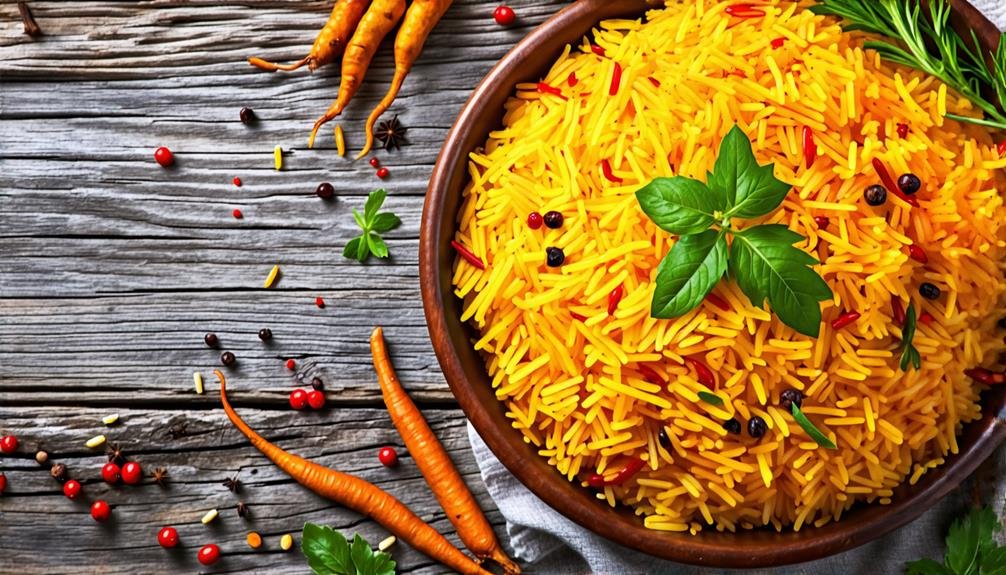
Saffron and turmeric are not just vibrant additions to rice pilaf; they each bring unique flavors and benefits that can enhance your dish. Saffron introduces a warm, earthy sweetness that infuses the rice with a luxurious touch, while turmeric contributes a beautiful golden hue along with its subtle nutty and peppery notes. Together, these spices create a harmonious balance, transforming a simple pilaf into a culinary delight that is both visually stunning and richly flavorful.
Saffron's Unique Flavor Profile
How can the unique tastes of saffron and turmeric elevate a rice pilaf into a culinary masterpiece? These two spices, cherished for their individual profiles, can enhance your dish remarkably. Saffron delivers a warm, earthy sweetness that dances on the tongue, while turmeric contributes a pleasant nutty sweetness with notes of ginger and pepper. Together, they create a flavorful symphony that captivates the senses.
Consider these four transformative attributes:
- Aromatic Richness: Saffron's deep fragrance and turmeric's vibrant scent create an enticing dish that invites diners to savor each bite.
- Visual Appeal: The golden hues from saffron and turmeric not only delight the eye but also ignite anticipation for the culinary adventure ahead.
- Cultural Heritage: These spices carry a rich history, infusing each mouthful with a sense of tradition, connecting you to a multitude of culinary practices.
- Versatile Combination: Saffron and turmeric harmonize beautifully with a range of ingredients, providing endless possibilities for creativity in your pilaf.
Integrating saffron and turmeric into your rice pilaf is a joyful celebration of taste that transcends the ordinary, encouraging you to explore the artistry of cooking. Embrace the opportunity to experiment!
Turmeric's Color and Benefits
Turmeric is a vital ingredient in rice pilaf due to its vibrant hue and extensive health benefits, enhancing both the dish's appearance and nutritional profile. This golden spice, often dubbed 'the golden miracle,' imparts a warm color that elevates the visual charm of your pilaf. Moreover, turmeric is celebrated for its anti-inflammatory properties, making it an excellent choice for health-conscious individuals.
Adding turmeric to your rice pilaf enhances the flavor with its subtle earthy undertones while reinforcing a dedication to wellness. When combined with saffron, another remarkable ingredient, turmeric creates a delightful fusion of color and taste that captivates the palate. Together, they transform a basic dish into an extraordinary culinary experience, offering both flavor and health benefits.
As you explore the versatility of turmeric, consider its compatibility with aromatic vegetables, nuts, and dried fruits, encouraging creativity in your culinary pursuits. Embrace turmeric in your rice pilaf, and witness it evolve into a dish that celebrates both flavor and well-being!
Customizing Your Pilaf
Enhancing your rice pilaf can be effortlessly achieved by integrating a selection of personalized ingredients and flavors that cater to your taste preferences. The charm of pilaf lies in its adaptability; you can create a dish that is uniquely yours. Here are some suggestions to ignite your imagination:
- Nuts: Incorporate toasted Marcona almonds or roasted pine nuts for a satisfying crunch and rich flavor.
- Dried Fruits: Add plump raisins or sweet apricots for a hint of sweetness that balances beautifully with savory spices.
- Fresh Herbs: Top with fresh cilantro or parsley to bring a burst of brightness and vibrant color to your dish.
- Aromatic Spices: Try adding Ceylon cinnamon or green cardamom for an exotic twist that elevates the flavor experience.
These enhancements not only deepen the flavor profile but also allow you to showcase your culinary creativity. Feel free to mix and match until you discover your ideal combination. The journey of customizing your pilaf is an exhilarating one, inviting you to explore flavors and textures that resonate with your palate. Embrace the culinary adventure, and let your imagination shine in the kitchen!
